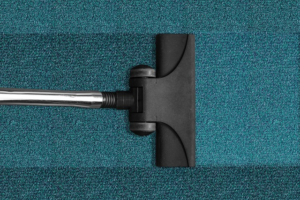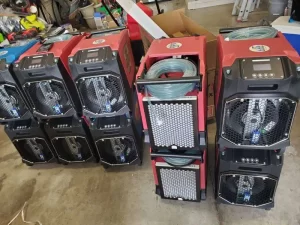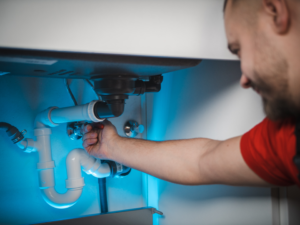A leak in the ceiling is a serious problem that can cause major damage or even make your whole ceiling collapse. It’s essential to get professional assistance with any floor or ceiling damage.
What causes ceiling leaks below a bathroom, and how can you find the source? Today, we’ll discuss some of the most common causes of a water leak in your bathroom, how to find the exact cause, and when it’s time to call TN Flood Kings for help.
What Causes a Ceiling Leak Below the Bathroom?

Your bathroom has a plentiful water supply: with toilets, bathtubs, showers, and sinks, there are plenty of places for hidden leaks to lurk. However, some of the actual causes might surprise you – let’s take a look.
Toilet Leaks

Your toilet is connected to water supply lines and then to a waste pipe, which ushers dirty water out of your bathroom and into the sewer. If the wax ring beneath the toilet wears away, or if the supply line springs a leak, it can cause water damage first to the bathroom floor, and then to the ceiling below.
Faucet and Sink Leaks
Your sink has something called a p-trap, which is a small bend in the pipe before it straightens out and drains. This keeps unpleasant gases from the sewers from rising up through the drains, as the water in the trap essentially neutralizes it.
If your sink trap gets clogged with excess debris like hair or soap buildup, you might experience a leaking drain.
Bathtub and Shower Leaks

Bathtubs, like sinks, have a p-trap that collects small amounts of water, and they can also get clogged. Porcelain is also a delicate material, and any hairline cracks caused by, for example, dropping a hard object in the tub, can lead to a leak.
As shower doors age, their seal breaks down, causing water leaks. Mildew and grime can also wear away at the grout, which leads to water damaged floors and ceilings. If you have these issues, call TN Flood Kings for a free estimate; we bill directly to insurance for peace of mind.
How to Find the Source of the Leak

First, you need to figure out which of the fixtures is leaking and where. Turn off the electricity to the area – water and electricity don’t mix!
Feel the drywall for a water stain or any sponginess; this can indicate that there are hidden leaks in the wall that need to be repaired. Don’t hesitate to cut through the wet drywall, as it will need to be replaced if it is at all water damaged.
If you don’t feel anything there, examine the floor and the seals around the toilet, sink, bathtub, and shower for a wet spot or a water stain.
Next Steps
Turn off the water and look at the sink traps to notice any dripping water that indicate the connections in the pipes must be tightened up.
With bathtubs and showers, put the stopper in the tub (or put a rag down the shower drain) and fill it with a small amount of water, then look for drips. This would indicate that the shower pan or the bathtub is cracked and must be replaced or repaired.
For toilets, you can put a bit of food coloring into the tank without flushing to check that the flapper is working correctly; if you see dye in the bowl, this means that the flapper must be replaced.
Unseat the toilet and examine the wax ring. If it’s broken or worn down, you need to replace it, and this may solve the leak.
How to Address Water Damage on the Ceiling Under the Bathroom
Any water damage to the ceiling or the bathroom floor requires professional assistance. You should not try to fix a ceiling leak on your own, as it may cause the entire ceiling to come down.
Cordon off both the bathroom and the ceiling below it before you can get TN Flood Kings in to examine the leak.
In the meantime, you should turn off the water and electricity, then set up fans or air movers to get air circulating. You can use painter’s tape to put plastic sheeting up around the area; this will help to concentrate the air circulation, and it will also serve as an obvious barrier.
Preventing Water Damage in Bathrooms

An ounce of prevention is worth a pound of cure, and you can ward off many a leak with these basic tips.
- Watch small children carefully when using the toilet or bathtub so that they do not overfill the tub or flush items down the drain.
- Inspect the caulk in the bathroom regularly and repair it as necessary.
- Only flush toilet paper; if you have a septic tank, use septic-safe paper.
- Use a fine mesh drain grille in showers to avoid hair clogs.
- Replace the wax seal under the toilet on schedule.
- Watch the water line in toilets to see if it is getting low.
You can’t prevent every possible leak, but fast intervention can prevent serious expenses.








